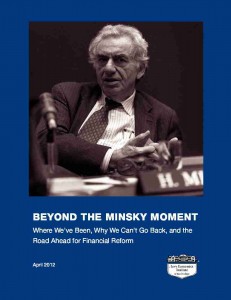Beyond the Minsky Moment
byFrom the Introduction to Beyond the Minsky Moment, a recent publication of the Levy Institute’s program on Monetary Policy and Financial Structure:
A new era of reform cannot be simply a series of piecemeal changes. Rather, a thorough, integrated approach to our economic problems must be developed; policy must range over the entire economic landscape and fit the pieces together in a consistent, workable way: Piecemeal approaches and patchwork changes will only make a bad situation worse.
—Hyman P. Minsky, Stabilizing an Unstable Economy
It’s been almost five years since the outbreak of the global financial crisis. Stepping back and surveying the last half decade’s worth of policy responses in the United States, what we see before us looks very much like the “piecemeal” and “patchwork” pattern of reform that Minsky cautioned against in Stabilizing an Unstable Economy (1986). What’s more, if there ever was any real political space for fundamental reform of the financial system, it has since disappeared, even as the economic wounds left by the crisis continue to fester. The battle to shape the rule-making and implementation process of the 2010 Dodd-Frank Act is ongoing, but as this monograph attempts to clarify, Dodd-Frank—indeed, the whole host of policy reactions (and nonreactions) since 2007—is largely undergirded by an approach to financial regulation that is incomplete and inadequate.
Another serious financial crisis, another so-called “Minsky moment,” may be required to reopen the window of opportunity for reform of the financial structure that goes beyond the piecemeal and patchwork. Understanding Minsky’s work can help us to evaluate the existing policy responses to the global financial crisis, to understand how the crisis emerged, and to help prepare us to better seize the next opportunity to fundamentally restructure and reregulate the financial system.
Despite the well-known phrase, Minsky’s approach had little to do with “moments.” It was about the sustained, cumulative processes in which periods of stability induce an endogenous increase in potential financial fragility. Fragility provides the fertile ground for financial instability, leading to a process of debt deflation and a full-blown Minsky crisis. …
Beyond the Minsky Moment traces the roots of the 2008 financial meltdown to the structural and regulatory changes leading from the 1933 Glass-Steagall Act to the Financial Services Modernization Act of 1999, and on through to the subprime-triggered crash. It evaluates the regulatory reactions to the global financial crisis—most notably, the 2010 Dodd-Frank Act—and, with the help of Minsky’s work, sketches a way forward in terms of stabilizing the financial system and providing for the capital development of the economy. Download it here.


